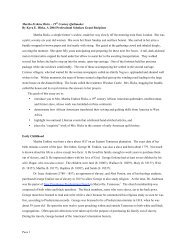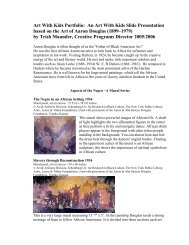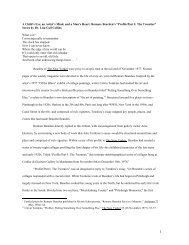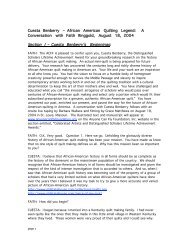Casting Feral Benga - The Anyone Can Fly Foundation, Inc.
Casting Feral Benga - The Anyone Can Fly Foundation, Inc.
Casting Feral Benga - The Anyone Can Fly Foundation, Inc.
Create successful ePaper yourself
Turn your PDF publications into a flip-book with our unique Google optimized e-Paper software.
By the time <strong>Feral</strong> <strong>Benga</strong> was completed, Barthé had skillfully established his relationshipwith both white and black Manhattan. As mentioned earlier, his search for professional andsocial freedom ended below 34 th Street among more diverse and mainstream artists andcollectors. However, Barthé quickly realized that freedom in an integrated neighborhood wasrelative not absolute, and further that homosexuals faced limitations regardless of location. 9Culture critic Manthia Diawara observed that open expression afforded white gays, within andwithout their communities, does not often extend to black gays who function under “thecamouflage of expressive forms such as music, dance, and transvestite attires, which are morereassuring to heterosexuals.” 10 Barthé revealed himself exclusively to those men and women ‘inthe life’; outside of those circles, he remained aloof and sexually neutral. He joined the HarlemArtists Guild, but was never an active member. 11 Once Barthé moved out of Harlem, his socialinvolvement was limited at best. His disinterest in women and marriage was considered areflection of Barthé's devotion to his art. With barriers compounded by race, black gay menexperience a heighten awareness of their otherness especially within black communities wherereligion, and a wish to be seen as ‘normal,’ leaves very little tolerance for alternate life ways.Barthé’s sculpture was his ‘camouflage.’ Nudes based on Classical models madecelebrating his homosexuality possible, while protecting the heterosexual public identity Barthéadvanced throughout his life. <strong>The</strong> sculptor also often gave his figures generic titles whicheffectively concealed the identities of individuals who inspired or posed for his genre figures. 12<strong>The</strong>y were also often hybrid compositions. For example, a dancer’s torso might be carried by thelegs of a basketball player, and the handsome face of a young street urchin would crown theassemblage. However, <strong>Feral</strong> <strong>Benga</strong>, actually titled for its living model, is a unique glimpse ofhow Barthé reinvented contemporaries realities to suit his taste for Classical art and its 16 thcentury renaissance.When Barthé visited Paris in 1934, <strong>Benga</strong> was already notorious in American andEuropean bohemian circles. <strong>The</strong> following year, then-amateur anthropologist Geoffrey Gorer’sAfrica Dances: A Book About West African Negroes was published. This slim volume’s travellogprose and snapshot photography became popular among Negrophiles interested in all aspectsof black culture. Africa Dances was dedicated to <strong>Benga</strong> who accompanied Gorer on his researchjourney through Western Africa. 13 Barthé’s knowledge of African dance developed with the helpof Gorer’s book, and his knowledge about <strong>Benga</strong> also increased.In his book, Gorer identified two distinct types of African dance – warlike and orgasmic.For Barthé the two types were interdependent. In <strong>Feral</strong> <strong>Benga</strong>, violence and sensuality vie fordominance, pain mingles with pleasure, male blends with female, and popular culture breaths lifeinto high art representation. A thoroughly self-contained figure, <strong>Feral</strong> <strong>Benga</strong> swoons trance-likein ecstasy. Such sexual innuendo boldly written on the black body was risqué for the time, butnot untapped by other artists. <strong>Feral</strong> <strong>Benga</strong>’s veiled androgyny was akin to the work of Barthé’sclose friend Richard Bruce Nugent. 14 Nugent was an eccentric artist who took great joy in overtdisplays of the Renaissance era’s propensity for racial and sexual intermingling by often layeringmultiple significations into his amusing and audacious drawings. 15 His Drawings for Mulattoes,for example, were Rorschach tests where each viewer brought something new to the picture.Racial, cultural, and gender bifurcation are tightly woven into complex narratives offered up indeceivingly simple forms. <strong>The</strong>se expressive methods were endemic to artists who, likechameleons, adjusted their identity to their immediate environment. What is revealed on thesurface might appear adequate, but what lies beneath offers substance.






